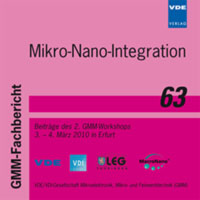Contactless Handling and Precision Positioning of Smallest Components for Assembly of Microelectronics
Conference: Mikro-Nano-Integration - 2. GMM-Workshops
03/03/2010 - 03/04/2010 at Erfurt, Germany
Proceedings: Mikro-Nano-Integration
Pages: 4Language: englishTyp: PDF
Personal VDE Members are entitled to a 10% discount on this title
Authors:
Braun, T.; Bauer, J.; Becker, K.-F.; Kahle, R.; Jung, E.; Koch, M.; Aschenbrenner, R. (Fraunhofer Institut für Zuverlässigkeit und Mikrointegration, Gustav-Meyer-Allee 25, 13355 Berlin, Germany)
Mollath, G. (Fraunhofer Institut Produktionsanlagen und Konstruktionstechnik, Pascalstraße 8-9, 10587 Berlin, Germany)
Reichl, H. (Technische Universität Berlin, Microperipheric Center, Berlin, Germany)
Abstract:
As the development of microelectronics is still driving towards further miniaturization, new materials, processes and technologies are crucial for the realization of future cost effective microsystems and components. Futures ICs and passives will also decrease in size, e.g. for RF-ID applications forecast die sizes are smaller than 250 µm, thicknesses less than 50 µm and pitches way below 100 µm. Passives, if not directly integrated into the system carrier, will be even smaller. Touchless and self-assembly based procedures seem to be a promising method for handling miniaturized components not directly fabricated at the very place where they are needed. Electrowetting on Dielectrics (EWOD) - a contactless handling technology well known from lab-on-chip applications for liquid transport, sorting, mixing and splitting - can be used as a basis for microelectronics assembly purposes on standard printed circuit boards. Handling shall be feasible for miniaturized components as chiplets, smallest SMDs as well as for nano-scaled building blocks. The physical principle is a change in the droplet contact angle of a droplet when immersed into an electrical field, an effect that can be used for droplet movement component transport. The process flow under evaluation starts with positioning of a droplet, containing a component, on a super-hydrophobic surface realized by a nano-particle filled coating of the carrier substrate with moderate accuracy. The droplet will be moved quickly until the desired position is reached using the mentioned electrowetting effect. Fine positioning and orientation of the component can then be achieved by magnetic guiding during evaporation of the water droplet. The crucial point of this approach is to find a suitable configuration of the magnetic field, which exerts such forces on the component needed for a movement in the wanted position. Besides the design of the magnetic field, the magnetic properties of the components are essential for the action of the field. Microelectronic components typically undergo only inadequate interaction with magnetic fields so that magnetically based positioning procedures fail. To overcome this difficulty, magnetically addressable markers must be designed and attached to the components. An effective technical realization of this principle is the application of thin polymer based layers, filled with magnetically interacting micro- or nano-particles, on top of the components. The layers can be applied cost-effectively on wafer level during fabrication of the components by use of e.g. common stencil printing process. Summarized the paper presents the results of a feasibility study for contactless device handling using EWOD and magnetic guidance of tiniest components.


